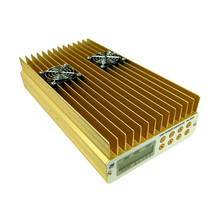
The TOPTEK PA-350V is an advanced and versatile high-power Solid State linear amplifier designed for Amateur Radio 2 Meter FM, SSB and CW VHF operations.
A large, easy-to-read green backlit Alphanumeric LCD provides simultaneous digital input power, output power and SWR readings. Front panel button actions and specialized, user-defined function readouts and menu selections are displayed, including incremental 100, 200, 300 and 350 Watt power output settings.
This VHF amplifier* delivers approximately 300 watts output with only 5 watts input from an HT or 350 watts maximum output with a VHF mobile.
The PA-350V has two selectable input ranges, Low 15W max and High 30W max, achieving 350 watts output with either 10 watts input or 15 to 25 watts input, to accommodate almost any VHF transceiver.
Multiple protection circuits, a Receive Low Noise Amplifier (LNA) with a bandpass filter, RF sense or PTT keying (required for SSB/CW) and thermostatically controlled fans are some of the great features of this top-of-the-line Toptek amplifier. True 50 ohm Type-N RF connectors maintain the highest efficiency to the feedline and antenna.
*Requires 13.8 VDC @ 50A max. (External power supply not included).
THIS UNIT WILL ONLY BE SOLD TO QUALIFIED AMATEUR RADIO OPERATORS AND MUST ONLY TRANSMIT ON AMATEUR FREQUENCIES. THE PURCHASER MUST PROVIDE PROOF OF THEIR AMATEUR RADIO QUALIFICATION. IF YOU DON'T HAVE AN AMATEUR RADIO (HAM) LICENCE PLEASE DON'T PURCHASE OTHERWISE WE WILL REFUND YOUR PURCHASE.
Features and Specifications:
- Frequency range: 135 MHz – 165 MHz
- FM mode: User programmable/selectable between 20 and 360 Watts
- User Selectable: 15 Watt Max./ 30 Watt Maximum
- SSB mode: 0 to 360 W max. PEP (set by transceiver output)
- Mode: Selectable FM or SSB
- RF Bypass Maximum: 50 Watts
- Bypass Insertion Loss: Typ. 0.35 dB @ 145 MHz
- RX Preamplifier Gain: typ. 20 dB @ 145 MHz
- Supply Voltage: 13.8 VDC**, Minimum: 10.5 VDC, Maximum: 14.5 VDC
- Supply Current at 350 W output (145MHz): 48 A continuous, 54 A Peak, max.
- External PTT Keying Connector: 3.5mm female stereo (1/8 in. TRS jack: ground Tip for PTT)
- RF Connectors: Type N female (50 ohm, low loss)
- Dimensions, w/o connectors: W-184 x H-90 x D-350mm
- Weight: 3 kg
CLICK HERE TO DOWNLOAD USER INFORMATION
WARNING: The transistors in the RF finals are expressly not covered by the manufacturers warranty. We do not accept 'change of mind', 'upgrade', 'not quite what I wanted' or 'swap' returns so be careful this is the model you want before purchasing.
Please Read Before Using:
- Do not use outside of the specified frequency ranges as damage may occur.
- Care needs to be taken that the antenna you are connecting to is in good condition and the VSWR is less than 1.5:1 on the frequency you are transmitting on.
- For higher power amplifiers (100+ watts) we recommend a single band antenna tuned to the frequency you are transmitting on.
- Never use an amplifier to attempt to compensate for a poorly tuned, high SWR antenna, for poor quality coaxial cable or connectors.
- We strongly recommend not using a power amplifiers with an indoor or loft antenna.
- Check the transmit power immunity of your vehicle if vehicle mounting as this may damage the electronics and/or disable your vehicle or functions of your vehicle.
- Be certain that the supply current from your power supply is ample for the peak current draw of the amplifier otherwise damage to the amplifier may occur.
- Be very careful when operating at high power and keep well clear of the transmitting antenna.
- Always check your antenna and feedline performance with an SWR meter on low power before increasing power to maximum.
- Do not overdrive the RF input of the amplifier.
- Do not operate the amplifier without a 50 ohm antenna or overrated dummy load connected to the antenna output.
- Do not operate your amplifier in hazardous environments - ie service stations, mines, etc
- Regularly or continuously test your antenna and feed line SWR for unexpected performance issues.
- Disconnect the antenna if lightning or storm activity is occurring nearby.
- Do not touch the antenna or exposed antenna connections when transmitting.
- Stop transmitting immediately if a fault appears.











